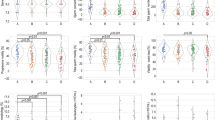Abstract
Purpose
Elevation of scrotal temperature has been known as a cause of male infertility but the exact mechanism leading to impaired spermatogenesis is unknown. This work aimed to investigate the role of elevated scrotal temperature, oxidative stress, and apoptosis in testes of infertile males associated with varicocele.
Methods
Thirty-two testicular biopsies from patients with left varicocele who underwent preoperative measurement of scrotal temperature (ΔT), serum follicle stimulating hormone (FSH), luteinizing hormone, and testosterone were included. Generation of 4-hydroxy-2-nonenal (4-HNE)-modified proteins and proteolytic fragments of poly(ADP-ribose) polymerase (PARP) and caspase-3 detected by Western blotting were examined as markers for oxidative stress and apoptosis, respectively. These expressions were compared with clinical parameters.
Results
Irrespective of varicocele grades, sperm concentration, motility, serum FSH, and testosterone were deteriorated with the increase of ΔT. There was a distinct correlation between generation of 4-HNE-modified proteins and ΔT, indicating a close association between scrotal temperature and oxidative stress. Cleavages of PARP and caspase-3, which appear at 86 and 17 kDa, respectively, were strongly correlated with ΔT and generation of 4-HNE-modified proteins.
Conclusions
Elevation of scrotal temperature is one of the major factors to impair spermatogenesis and steroidogenesis in testis with varicocele. This heat stress is shown to be closely associated with oxidative stress, following the apoptosis of germ cells.


Similar content being viewed by others
References
Bujan LM (1995) Testicular heating and its possible contributions to male infertility: a review. Int J Androl 18:169–184
Jung A, Schuppe HC (2007) Influence of genital heat stress on semen quality in humans. Andrologia 39:203–215
Hjollund NHI, Storgaard L, Ernst E et al (2002) Impact of diurnal scrotal temperature on semen quality. Reprod Toxicol 16:215–221
Yamaguchi M, Sakatoku J, Takihara H et al (1989) The application of intrascrotal deep body temperature measurement for the noninvasive diagnosis of varicocele. Fertil Steril 52:295–301
Turner TT, Lysiak JJ (2008) Oxidative stress: a common factor in testicular dysfunction. J Androl 29:488–498
Köksal IT, Tefekli A, Usta M et al (2000) The role of reactive oxygen species in testicular dysfunction associated with varicocele. BJU Int 86:549–552
Shiraishi K, Naito K (2005) Increased expression of Leydig cell heme oxygenase-1 preserves spermatogenesis in varicocele. Hum Reprod 20:2608–2613
Shiraishi K, Naito K (2006) Generation of 4-hydroxy-2-nonenal modified proteins in testis predicts improvement in spermatogenesis after varicocelectomy. Fertil Steril 86:233–235
Shiraishi K, Naito K (2007) Effects of 4-hydroxy-2-nonenal, a marker of oxidative stress, on spermatogenesis and expression of p53 protein in male infertility. J Urol 178:1012–1017
Buttke TM, Sandstrom OA (1994) Oxidative stress as mediators of apoptosis. Immunol Today 15:7–10
Paul C, Teng S, Saunders PTK (2009) A single, mild, transient scrotal heat stress causes hypoxia and oxidative stress in mouse testes, which induces germ cell death. Biol Reprod 80:913–919
Jung A, Leonhardt F, Shill WB et al (2005) Influence of the type of undertrousers and physical activity on scrotal temperatures. Hum Reprod 20:1022–1027
Bengoudifa B, Mieusset R (2007) Thermal asymmetry of the human scrotum. Hum Reprod 22:2178–2182
Wang C, Berman N, McDonald V et al (1997) Effect of increased scrotal temperature on sperm production in normal men. Fertil Steril 68:334–339
Mieusset R, Bujan L, Mondinat C et al (1987) Association of scrotal hyperthermia with impaired spermatogenesis in infertile men. Fertil Steril 48:1006–1011
Zorgniotti AW, Sealfon AI (1998) Measurement of intrascrotal temperature in normal and subfertile men. J Reprod Fertil 82:563–566
Ahotupa M, Huhtaniemi I (1992) Impaired detoxification of reactive oxygen and consequent oxidative stress in experimentally cryptorchid rat testis. Biol Reprod 46:1114–1118
Ikeda M, Kodama H, Fukuda J et al (1999) Role of radical oxygen species in rat testicular germ cell apoptosis induced by heat stress. Biol Reprod 61:393–399
Benoff SH, Millan C, Hurley IR et al (2004) Bilateral increased apoptosis and bilateral accumulation of cadmium in infertile men with left varicocele. Hum Reprod 19:616–627
Cam K, Simsek F, Yuksel M et al (2004) The role of reactive oxygen species and apoptosis in the pathogenesis of varicocele in a rat model and efficiency of vitamin E treatment. Int J Androl 27:228–233
Setchell BP (1998) The Parkes lecture. Heat and the testis. J Reprod Fertil 114:179–194
Izu H, Inouye S, Fujimoto M et al (2004) Heat shock transcription factor 1 is involved in quality-control mechanisms in male germ cells. Biol Reprod 70:18–24
Lue YH, Hikim AP, Swerdloff RS et al (1999) Single exposure to heat induces stage-specific germ cell apoptosis in rats: role of intratesticular testosterone on stage specificity. Endocrinology 140:1709–1717
Hassan A, El-Nashar EM, Mostafa T (2009) Programmed cell death in varicocele-bearing testes. Andrologia 41:39–45
Yin Y, DeWolf WC, Morgentaler A (1998) Experimental cryptorchidism induces testicular germ cell apoptosis by p53-dependent and -independent pathways in mice. Biol Reprod 58:492–496
Morgentaler A, Stahl BC, Yin Y (1999) Testis and temperature: an historical, clinical, and research perspective. J Androl 20:189–195
Lenzi A, Culasso F, Gandini L et al (1993) Placebo-controlled, double-blind, cross-over trial of glutathione therapy in male infertility. Hum Reprod 8:1657–1662
Kessopoulou E, Powers HJ, Sharma KK et al (1995) A double-blind randomized placebo cross-over controlled trial using the antioxidant vitamin E to treat reactive oxygen species associated male infertility. Fertil Steril 64:825–831
Conflict of interest statement
The authors have no conflicts of interest.
Author information
Authors and Affiliations
Corresponding author
Rights and permissions
About this article
Cite this article
Shiraishi, K., Takihara, H. & Matsuyama, H. Elevated scrotal temperature, but not varicocele grade, reflects testicular oxidative stress-mediated apoptosis. World J Urol 28, 359–364 (2010). https://doi.org/10.1007/s00345-009-0462-5
Received:
Accepted:
Published:
Issue Date:
DOI: https://doi.org/10.1007/s00345-009-0462-5




